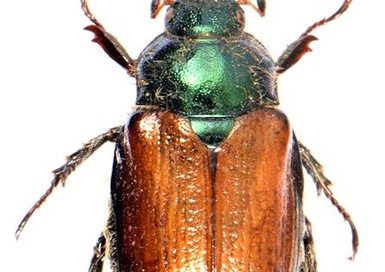The Garden Chafer Invasion
Donald describes bearing witness to a recent "Beetle Crash" on the Durness Coast
As we were walking across the amazing Balnakeil beach, on a recent guided walk, I bore witness to an amazing phenomenon. Lots of little wriggling insects on the strandline.
A closer inspection revealed them to be my headline beetle, the garden chafer Phyllopertha horticola (Linnaeus, 1758), quite common across the UK really but not usually in the numbers we were witnessing.
I had seen this many years earlier too, in the same area and not knowing then what species they were, I sent a sample off to a learned friend Peter Entwistle, my entomologist guru. He quickly identified them as Phyllopertha horticola. That year there were hundreds of thousands of them, enough to shovel off the shoreline, washed into the sea by the offshore winds. Such numbers are known as a “beetle crash” which is not uncommon.
Although generally common throughout its range - this species has a rather restricted central and northern European distribution. In the UK it is locally common from lowlands to about 300m and is generally more common in western areas. Typical habitats include parkland, wooded pasture and grassland generally, especially calcareous grassland – which explains why it is so numerous in the limestone area of Durness.

Adults occur from mid-May until July and are diurnal; they are active in warm weather when they may be seen on a variety of flowers. They mate nocturnally, usually on the ground, from mid-to late-May after a period of maturation feeding on tree and shrub foliage. Oviposition begins during late May; females lay up to 30 eggs in the soil, generally between 5 and 20cm deep. Larvae hatch within 3 weeks and immediately begin feeding upon fine roots, they remain deep in the soil and develop rapidly for a few weeks. In September and October, they feed directly on roots under turf and at this time suffer predation from birds, which may damage turf in order to find them, but they soon begin to move down into the soil to overwinter. As one can imagine these beetles are not beloved of gardeners or golfers who tend so carefully to their pristine grassland and lovingly cut greens.
Larvae are generally fully grown before they overwinter but may feed for a further period during March when they move up through the soil prior to pupation which usually occurs in a cell between 20 and 20 cm below the surface. Adults eclose after 3 or 4 weeks and remain in the soil for a few days as they harden and colour, their emergence from the soil is often synchronized and large numbers may suddenly appear on nearby flowers and foliage; they often occur on Crataegus and Viburnum flowers and may be seen flying among blossom on warm days. The species was formerly much more common throughout its range and has in the past been an occasional pest of turf and young tree and shrub seedlings. Perhaps the prolific use of pesticides has diminished its numbers, as is the case with most of our valuable pollinators.

The value of the beetle as a bonus bird food was obvious across the whole dune system here, gulls spread themselves out amongst most of Faraid head SSSI, marching like frontline troops and feeding on beetle with each step. For weeks afterwards I was finding bird pellets full of beetle cases littering the ground. On this particular walk it was impossible to step and not crush at least one chafer, there were more on the paths than in the air.
They are a beautiful beetle, many beetles are amazing, splendid, shining, metallic living pieces of insect jewellery, we should appreciate them more. I don’t mind a few dead spots on my lawn to allow for this gem to be about.
Thanks to UK beetles for the information, they have a wonderful website which is worth a look.
Donald Mitchell is a High Life Highland Countryside Ranger, a keen observer of nature and wildlife, he dedicates his time to documenting and sharing insights about the natural habitats in North West Sutherland. With a particular interest in marine life, he aims to help others gain a deeper understanding and respect for the delicate balance of our ecosystem.
Children's Storytime : Gus and Petal
Once upon a time, in a windy place by the sea, there was a tiny but brightly colourful pink flower named Petal. Petal was very small compared to the big sea and wide sky around her, and sometimes she felt a little bit lonely all by herself, perched in a crevice in a rock on the cliffs.






